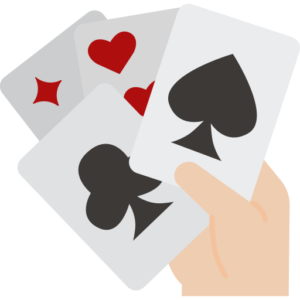Glossary Term
Donk Bet
Donk Bet
Used In: Poker
Introduction
A donk bet is a term used in poker to describe an unusual move where a player bets out of position, typically on the flop, when they weren’t the aggressor before the flop. This term often carries a negative connotation because it goes against standard betting patterns. Normally, a player who has raised pre-flop would continue to bet on the flop, while the player in the donk bet position would check and then react. When a player bet out of turn, it can throw off the flow of the game, leading opponents to question the strength of their hand.
The donk bet is commonly seen as a sign of weakness or a lack of strategy. Players making a donk bet are often perceived as having a marginal hand, trying to control the action, or simply throwing off their opponents with an unexpected move. However, it’s not always the case. Skilled players may use donk betting as a strategy to confuse or mislead their opponents, or to extract value from hands they wouldn’t normally be able to in more traditional betting scenarios.
While donk betting is often associated with lower stakes or beginner players, it can be an effective tool when used strategically. The key is understanding when to make a donk bet and how to follow it up. If done correctly, it can be a way to create pressure, steal pots, or get value from hands that otherwise wouldn’t command much attention. However, overusing this tactic can lead to being easily read by experienced players, so it's essential to use it sparingly and in the right situations.
In Depth Look
Typically, the player who raises pre-flop is expected to continue betting after the flop. However, the donk bet breaks this pattern by having the player in the passive position take the initiative. This often signals to other players that the bettor has a weak hand or is attempting to take control of the situation. While it can be viewed negatively, skilled players can use donk betting as a strategic move to confuse opponents or disrupt the normal flow of the hand. It is a move that challenges conventional poker logic and can create an unpredictable environment at the table.
Donk betting is not without its risks. If overused or executed poorly, it can make a player appear inexperienced and lead to easy reads by opponents. At higher stakes, experienced players may identify a donk bet as a sign of desperation or weakness, quickly capitalizing on it. However, if used in the right context, donk betting can be a powerful weapon, especially when the player has a strong read on their opponents. The key to making a successful donk bet lies in understanding the tendencies of your opponents and when they are likely to fold to unexpected aggression. It’s a delicate balance between confusing your opponents and not becoming predictable yourself.
Key Points:
-
Donk bet occurs when a player bets out of position, usually on the flop.
-
It’s often seen as a sign of weakness but can be used strategically to control the action.
-
Overusing donk betting can lead to being read easily by opponents.
-
Successful donk betting relies on understanding the dynamics of the table and opponents’ tendencies.
Mechanics
The mechanics of a donk bet involve a player betting on the flop when they are not the pre-flop aggressor. This means the player has called or checked the pre-flop raise and is now in a position where they decide to lead out with a bet. Typically, players who have raised pre-flop are expected to continue betting on the flop, so when a player in the passive position (out of position) takes the lead, it stands out. This sudden aggression can catch opponents off guard, disrupting their expected range of actions. The donk bet is often made to take control of the hand, force opponents to fold, or induce them to make mistakes by overvaluing their hands.
In practice, the player making the donk bet must have a clear purpose behind the move. A donk bet can be used to extract value from a hand that’s likely to be the best but isn’t strong enough to raise. For example, if the player has a decent hand but not one strong enough to raise, they might opt to donk bet to build the pot or force the pre-flop raiser to play passively. Alternatively, it can be used as a bluff to represent strength, hoping to pressure opponents into folding. Regardless of the intent, the donk bet introduces uncertainty into the hand, forcing opponents to react to an unusual situation. However, it’s important to remember that when the donk bet is overused, experienced players can start to exploit it, making it essential for the bettor to mix up their strategy.


Illustrated Example
Imagine you're playing a no-limit Texas Hold'em game, and you’re holding a hand like 8♠ 9♠. You’re in the big blind and the player in the cutoff raises to 3x the big blind. You decide to call and see the flop. The flop comes 7♠ 10♠ 2♦, giving you both a flush draw and a straight draw. Normally, the pre-flop raiser would continue betting on the flop, but instead, you decide to lead out with a bet of half the pot. This is a donk bet. You’re not the pre-flop aggressor, yet you’re taking the lead in the hand with a draw, which is unusual and could make your opponent think twice.
In this situation, your opponent might be confused by your donk bet. They could interpret it in different ways: maybe you have a strong hand like two pair, or perhaps you’re just betting with a draw to take control of the hand. If they have a marginal hand, they might decide to fold, not wanting to face more aggression. On the other hand, if they have a strong hand, they could raise, allowing you to either fold (if you’re not confident) or play aggressively (if you hit your draw on the turn or river). The key to this donk bet is that you're disrupting the flow of the hand by forcing the pre-flop aggressor to make a decision out of turn. Your goal is either to take the pot down immediately or to gain information while potentially setting up a bigger play later in the hand.
| Player | Action | Hand | Flop | Reason for Action |
|---|
| You (Big Blind) | Call pre-flop, donk bet half pot on the flop | 8♠ 9♠ | 7♠ 10♠ 2♦ | Lead with a draw (flush & straight) |
| Opponent (Cutoff) | Raise, call, or fold | TBD | 7♠ 10♠ 2♦ | Respond to donk bet, unsure of your hand |
Player Perspective
From the player's perspective, a donk bet can be a valuable tool when used correctly, but it requires careful consideration of the situation. If you are the player making the donk bet, you're essentially breaking from the standard flow of the game by betting when you're not the pre-flop aggressor. This can give you the chance to take control of the hand and potentially steal the pot if your opponent is uncertain about your hand. For example, if you're holding a draw, such as a flush or straight draw, a donk bet can build the pot or apply pressure to the pre-flop raiser, making them question whether you're holding a strong hand or just attempting to control the action. The key is to be unpredictable and make moves that keep your opponents off balance.
However, from the player's perspective, donk betting can also backfire if used too often or in the wrong situations. Overusing it may make you seem inexperienced or overly aggressive, allowing savvy opponents to exploit your tendency. Skilled players might catch on to your strategy and start calling or raising more frequently, knowing that you often lead out with weaker hands or draws. To make the donk bet work, it’s important to mix it into your overall strategy and use it selectively. If you do it too predictably, experienced players will catch on and adjust, so it’s essential to keep them guessing and vary your approach when choosing to make a donk bet.
Conclusion
A donk bet is an unorthodox but potentially effective strategy in poker, especially when used strategically and selectively. While it can disrupt the flow of the game and put pressure on opponents, it requires careful execution to avoid being easily exploited. Players who use donk bets must remain aware of their opponents' tendencies and adjust accordingly. When done in the right situations, a donk bet can be a powerful tool to control the action and gain an edge. However, overusing it or using it without a clear purpose can lead to predictability and weakness. Like any poker move, the key is balance and adaptability.
The Top Online Casinos for Playing Poker
These platforms prioritize player satisfaction by providing intuitive interfaces, seamless gameplay experiences, and robust security measures to ensure a fair and enjoyable environment for all users.


Author
Branimir Ivanov | Senior News Contributor
- TABLE OF CONTENTS








